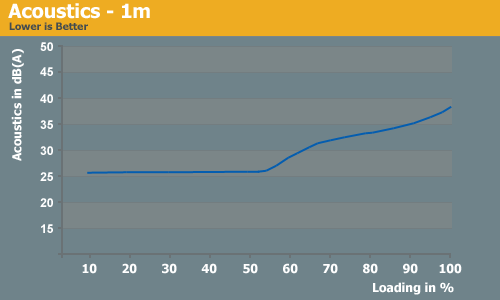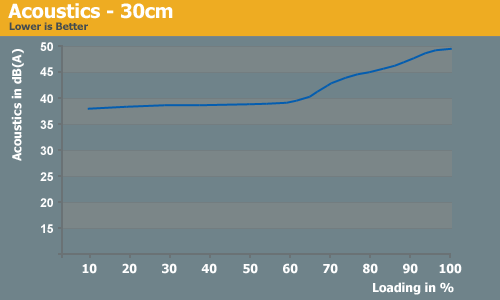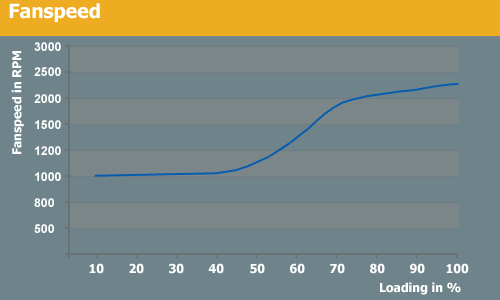The Single 12V Rail SilverStone Olympia OP650
by Christoph Katzer on July 13, 2007 12:00 PM EST- Posted in
- Cases/Cooling/PSUs
Acoustics
The fan control does a good job on this model. The fan is rotating with a minimum speed with up to a 50% load on the power supply. This means you can put a little more than 300 watts load on it before you will experience an increase in PSU noise. The tests re conducted in a special room which isolates the power supply from the noisy Chroma. In this way we can get accurate measurements of the power supply only. The microphone is measuring in two different loacations. The first one is around 30cm far from the backside of the power supply and the second measurement is being taken from 1m distance. The ambient-noise is minimized through the 5-layer thick wall containing different isolating materials.
Running in an average system, the measured 26 dB(A) would not be the loudest thing to worry about and wouldn't significantly contribute to the overall SPL of the system. If running with more than 60% the fan will constantly spin faster and reach up to 38 dB(A) noise which is still an acceptable result for most PCs but not really calm anymore.
From a subjective point of view the noise is not too loud either. The power supply didn't produce any noise other than from the fan which can be quite bothersome from time to time. There is no ticking noise from the fan either.



The fan control does a good job on this model. The fan is rotating with a minimum speed with up to a 50% load on the power supply. This means you can put a little more than 300 watts load on it before you will experience an increase in PSU noise. The tests re conducted in a special room which isolates the power supply from the noisy Chroma. In this way we can get accurate measurements of the power supply only. The microphone is measuring in two different loacations. The first one is around 30cm far from the backside of the power supply and the second measurement is being taken from 1m distance. The ambient-noise is minimized through the 5-layer thick wall containing different isolating materials.
Running in an average system, the measured 26 dB(A) would not be the loudest thing to worry about and wouldn't significantly contribute to the overall SPL of the system. If running with more than 60% the fan will constantly spin faster and reach up to 38 dB(A) noise which is still an acceptable result for most PCs but not really calm anymore.
From a subjective point of view the noise is not too loud either. The power supply didn't produce any noise other than from the fan which can be quite bothersome from time to time. There is no ticking noise from the fan either.













46 Comments
View All Comments
Araemo - Friday, July 13, 2007 - link
That makes sense, and makes me think my guess about the 20A limit is possibly a contributing factor - It would be a safety issue if someone hung 40A worth of fans, lights, motorized case windows, whatever you want.. off of one pair of wires (IE, one molex connector feeding into the mass of extenders and passthrough connectors that most fans and lights I've seen use.).You'd likely overheat the wires carrying all that power, if not the connectors as well, which could cause fire or electrocution hazards.
While a GPU may draw significantly more than 20A, they are also using 3 pairs now, so the actual power draw will be closer to 20A per pair.
DerekWilson - Friday, July 13, 2007 - link
The PCIe V2.0 PSUs I've seen suggest only using connectors from the same 12V rail for PCIe graphics cards -- because if you don't, you'll be connecting the common from two different 12V rails together.This can cause issues.
If a graphics card has one 4pin and 1 8pin connector, like the HD 2900 XT, the GPU can potentially draw up to 225W from a single 12V rail through 2x PCIe graphics power connectors (3 pairs). That's about 19 amps through one rail for one PSU, but not over each pair.
SilthDraeth - Friday, July 13, 2007 - link
They explained it.The Intel ATX standard calls for no more than 20 Amps per 12V rail. So in order to avoid maxing out a single 12V rail at 20 Amps, PSUs have multiple rails support up to 20 Amps each.
If you use a single rail that can max out at 54 Amps as stated here, then you do not need the additional rails, but you are going against the ATX standard.
Duraz0rz - Friday, July 13, 2007 - link
Also, I didn't see if there was a reason that it was advertised as a single rail, yet you have 4 12V rails.Nice article...really love the line curves for the load outputs. One thing I noticed missing is ripple testing. Any reason why it's not here?
SilthDraeth - Friday, July 13, 2007 - link
That confused me as well. I think they mentioned that the PSU supposedly includes an ability to turn the other rails off, but it doesn't work, and it always has 4. They did state the PCB was originally designed for 4 rails.Duraz0rz - Friday, July 13, 2007 - link
Nevermind...disregard my statement about the ripple testing. I probably just missed it in the original article after skimming the comments from it :)